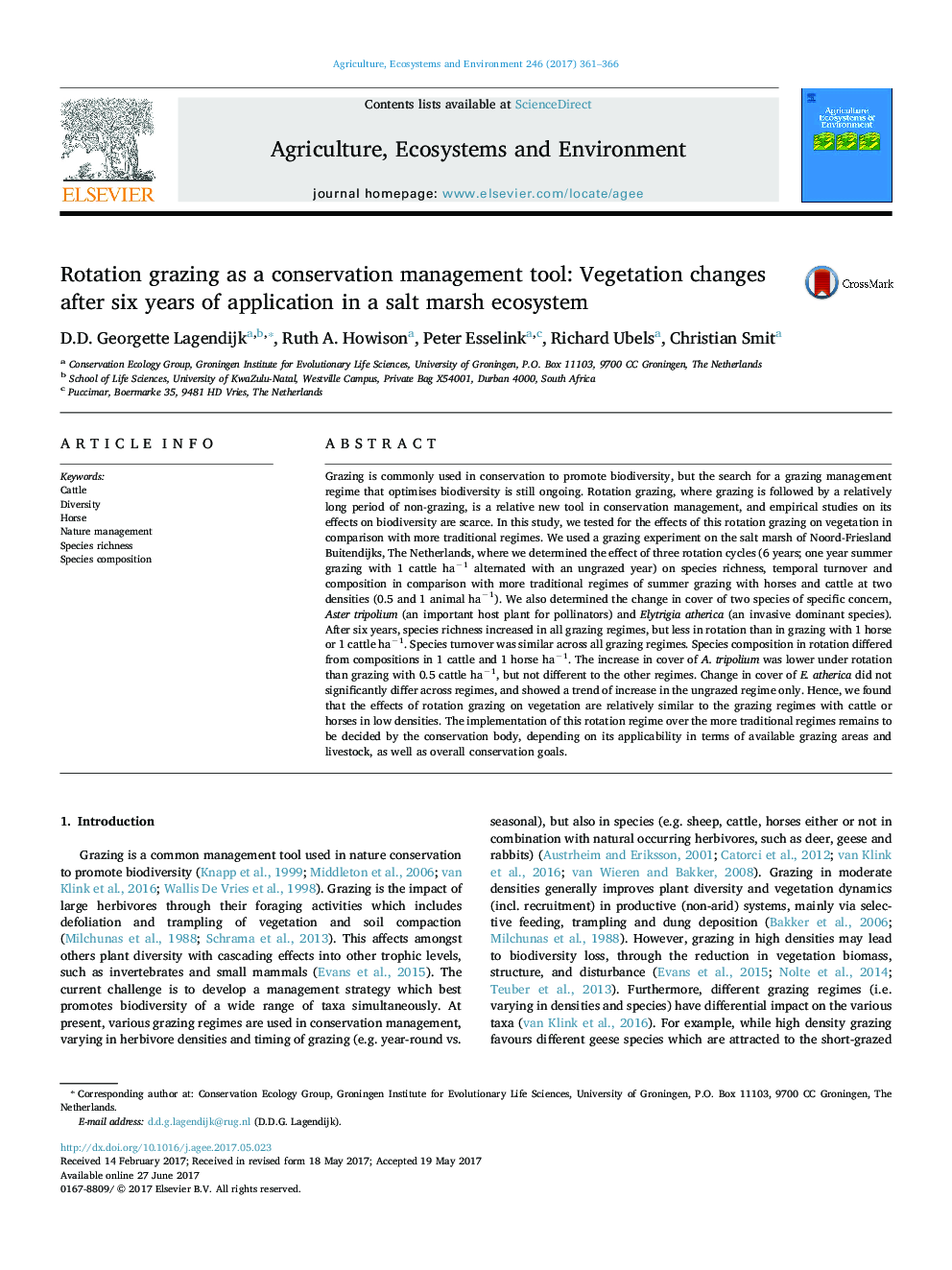| کد مقاله | کد نشریه | سال انتشار | مقاله انگلیسی | نسخه تمام متن |
|---|---|---|---|---|
| 5538058 | 1552006 | 2017 | 6 صفحه PDF | دانلود رایگان |
عنوان انگلیسی مقاله ISI
Rotation grazing as a conservation management tool: Vegetation changes after six years of application in a salt marsh ecosystem
ترجمه فارسی عنوان
چراغ چرخشی به عنوان یک ابزار مدیریت حفاظت: گیاه پس از شش سال استفاده در یک اکوسیستم نمکی شبیه تغییر می کند
دانلود مقاله + سفارش ترجمه
دانلود مقاله ISI انگلیسی
رایگان برای ایرانیان
کلمات کلیدی
گاو، تنوع اسب، مدیریت طبیعت، غنای گونه، ترکیب گونه ها،
موضوعات مرتبط
علوم زیستی و بیوفناوری
علوم کشاورزی و بیولوژیک
علوم زراعت و اصلاح نباتات
چکیده انگلیسی
Grazing is commonly used in conservation to promote biodiversity, but the search for a grazing management regime that optimises biodiversity is still ongoing. Rotation grazing, where grazing is followed by a relatively long period of non-grazing, is a relative new tool in conservation management, and empirical studies on its effects on biodiversity are scarce. In this study, we tested for the effects of this rotation grazing on vegetation in comparison with more traditional regimes. We used a grazing experiment on the salt marsh of Noord-Friesland Buitendijks, The Netherlands, where we determined the effect of three rotation cycles (6 years; one year summer grazing with 1 cattle haâ1 alternated with an ungrazed year) on species richness, temporal turnover and composition in comparison with more traditional regimes of summer grazing with horses and cattle at two densities (0.5 and 1 animal haâ1). We also determined the change in cover of two species of specific concern, Aster tripolium (an important host plant for pollinators) and Elytrigia atherica (an invasive dominant species). After six years, species richness increased in all grazing regimes, but less in rotation than in grazing with 1 horse or 1 cattle haâ1. Species turnover was similar across all grazing regimes. Species composition in rotation differed from compositions in 1 cattle and 1 horse haâ1. The increase in cover of A. tripolium was lower under rotation than grazing with 0.5 cattle haâ1, but not different to the other regimes. Change in cover of E. atherica did not significantly differ across regimes, and showed a trend of increase in the ungrazed regime only. Hence, we found that the effects of rotation grazing on vegetation are relatively similar to the grazing regimes with cattle or horses in low densities. The implementation of this rotation regime over the more traditional regimes remains to be decided by the conservation body, depending on its applicability in terms of available grazing areas and livestock, as well as overall conservation goals.
ناشر
Database: Elsevier - ScienceDirect (ساینس دایرکت)
Journal: Agriculture, Ecosystems & Environment - Volume 246, 1 August 2017, Pages 361-366
Journal: Agriculture, Ecosystems & Environment - Volume 246, 1 August 2017, Pages 361-366
نویسندگان
D.D. Georgette Lagendijk, Ruth A. Howison, Peter Esselink, Richard Ubels, Christian Smit,
